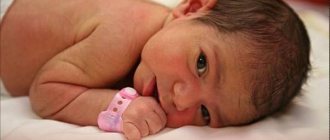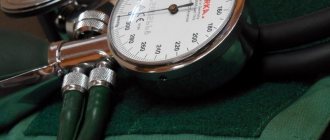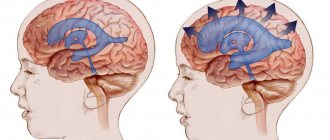Causes of neurological disorders
- hereditary;
- infectious;
- traumatic.
- metabolic (as a result of metabolic disorders, including those caused by malabsorption in the gastrointestinal tract);
- immunological.
As is already clear from the names, hereditary diseases are transmitted from parents to children.
They are genomic and chromosomal. A striking example of a chromosomal disease is Down syndrome. However, there are also less studied disorders that are more difficult to diagnose. Genomic diseases can affect developmental disorders of the central nervous system, musculoskeletal system, and endocrine system. All these disorders can be detected during examination. The disease is sometimes associated with injuries received by the child, including birth injuries. The simplest example is a concussion resulting from mechanical impact (fall, blow). Symptoms: dizziness, nausea, headache, loss of consciousness, tinnitus. These symptoms are associated with disturbances in the regulation of the central nervous system and disappear after treatment.
Disorders of an infectious nature arise as a result of an infection suffered by a child. Sometimes this is a consequence of an illness suffered by the mother during pregnancy. The effects of viruses, parasites, fungi, and bacteria cannot pass without leaving a trace. It can lead to brain damage and related complications. Complications often arise from diseases such as measles, chicken pox, rubella, whooping cough, mumps, tonsillitis, otitis media, malaria, and encephalitis.
Metabolic and immunological disorders are associated with disorders in various organs and systems that ensure the normal functioning of the central nervous system. The work of the whole body is aimed at ensuring the proper functioning of the brain. And any violations directly affect neurological disorders, especially in children of a younger age group, who do not yet have the various compensatory mechanisms of brain protection that an adult has.
Symptoms
If there are any signs of illness, do not risk your child’s health - consult a doctor! Choose a specialist yourself or contact our help desk. The best doctors in Moscow are ready to see you:
291 pediatricians, 166 neurologists, 40 of them take house calls.
Diseases of the nervous system in children may not manifest themselves immediately. They also arise under the influence of several factors. The reasons overlap each other and manifest themselves as a result. The consequences are felt already in adulthood. Childhood diseases of the nervous system develop into serious neuroses, which are much more difficult to cure. For example, all kinds of disturbances in the functioning of the psychomotor system.
Make an appointment
Symptoms of disorders are expressed in different ways. They can manifest themselves in the child's periodic twitching, blinking, and shrugging of shoulders. Such contractions affect the muscles of the legs, arms, and face. Typical symptoms that characterize neurological diseases in children are repetitive actions: tapping, walking from one side to the other, shifting an object. Symptoms also include various smacking, coughing, and snoring.
The main symptoms indicating nervous diseases in children include:
- fainting,
- insomnia,
- enuresis,
- poor appetite
- teak,
- hypochondria,
- headache.
Symptoms of neurological diseases
Symptoms may vary depending on the severity of the disorders and their causes. Alarming symptoms for parents are:
- sleep disturbances in a child, constant headaches;
- problems with headaches when the weather changes;
- decreased academic performance, memory impairment;
- fast fatiguability;
- hyperactivity, mood swings;
- nervousness;
- various speech disorders;
- impaired mental function;
- problems with urination (enuresis);
- general weakness;
- the appearance of weakness in the limbs;
- obsessive behavior, tics;
- loss of previously acquired skills;
- convulsions.
In order for parents to have a reason to visit a neurologist, it is not necessary to wait until all of the listed symptoms appear. Usually the child has a specific problem. This could be a sharp decline in academic performance, the appearance of nervousness, or behavioral disturbances. Young children may lose previously acquired skills and develop speech disorders. If a child does not speak at 2 years old, this is also a reason to visit a specialist who will conduct the necessary diagnostics and prescribe treatment.
As statistics show, in most cases healthy children are born. But as always, there are exceptions to all rules and sometimes children can be born with a variety of pathologies, which, of course, causes great concern among parents. Today there are a lot of pathologies and it is simply unrealistic to list them all, but it is worth remembering those that occur most often.
Differences between birth injuries and pathologies. Birth injuries are health problems in a child that occurred due to a difficult birth, errors of medical personnel or the mother herself. Damage can be of any kind and of varying severity, from bruises to shoulder dislocation. Pathology in newborns is considered to be deeper injuries that are not immediately diagnosed. The reasons for this can be completely different factors. Some of these include problems with the central nervous system, with the development of organs and systems, and chromosomal mutations. If we consider the classification of such pathologies, we can distinguish those that occurred due to genetic disorders and those that were acquired.
Chromosomal pathology of the fetus. Down syndrome is considered one of the most common pathologies. There have been more and more cases of sick children being born lately. Unfortunately, there are no preventive measures for this disease. Healthy parents often give birth to sick children, and scientists still cannot say exactly why this happens. However, you can learn about this pathology of newborn children in the first half of pregnancy. For this purpose screening is done. After the woman finds out about this, she can make a choice: keep the child or get rid of him. This is a personal decision for every girl, so you shouldn’t judge her for it. It is imperative that if there are such prerequisites for problems, the maternal history is studied. Pathologies in newborns are sometimes transmitted through hereditary factors. Girls may develop Shereshevsky-Turner disease. This disease is unique to girls. It is often found at the age of 10. It is accompanied by the development of a mild degree of retardation, as well as infertility. The disease is characterized by the absence of one chromosome type X. The pathology of newborn boys is Kleinfelter's disease. Manifested by high growth and inability to have children. Characterized by the presence of the 47th chromosome. In addition to these diseases, there are a number of diseases that develop due to problems with chromosomes, but those described are the most common. Prevention of chromosomal problems. There are two options that will allow you to avoid having sick children. The first of these is consultation with a specialized doctor before pregnancy. The second option is screening at a certain stage of pregnancy. You cannot delay, because after the time runs out, the answers will be incorrect. Therefore, the study must be done strictly when the doctor says. After this, you can decide what to do with the child if it turns out that he is sick.
“Acquired” pathologies. Doctors are already tired of repeating to every woman that they must prepare for their pregnancy. At least a few months before conception, it is worth undergoing an examination to determine whether there are any diseases, transfer chronic ones to a state of remission, and cure acute ones. Be sure to get tested by a geneticist. Forget about your bad habits. You need to treat pregnancy with maximum responsibility. It is important to visit the doctor on time, constantly tell him about your health and take the tests that he will prescribe. Don't forget about the recommendations. Pathologies of newborns and premature babies often arise due to the fact that a woman neglects both herself and her baby during pregnancy. There is a high probability of pathology if less than 18 months have passed between births. In this case, the prognosis for the health and survival of children is significantly worse. The mortality rate of children born after an interval between pregnancies of less than two years is 60% higher than in the case of births with an interval of 4 years or more. Unplanned pregnancy increases the risk of low birth weight babies, which is a risk factor for poor child health.
Formation of organs. The formation of organs may be disrupted due to severe stress or heavy load. Most often the heart, kidneys, lungs, and eyes are affected, but problems can affect any part of the body. Sometimes a child develops extra fingers. As a rule, environmental influences lead to such pathology. Ecology is one of the factors. In addition, alcohol, cigarettes, antibiotics are also some of the causes of pathologies. Giving up bad habits is not so difficult if you understand why it is being done. It also happens that pathologies actually arise due to factors that cannot be influenced. And in such cases, modern medical care can help the child, but the doctor must be ready for surgery immediately after birth. Therefore, do not forget about visits to your specialist so that he conducts examinations, and if anything happens, you are prepared for some unpleasant news. If you diagnose the problem in time, you will not only alleviate the child’s condition, but also cure him completely (in some cases).
Causes and treatment of hyperexcitability and hyperactivity. Trauma during childbirth, lack of oxygen during pregnancy, infection in the womb - all this leads to cerebral hypoexcitability. The disease has certain symptoms that will allow you to recognize the problem immediately after childbirth. The child will have too weak muscles, will be very drowsy, and will not want to eat. Such children are lethargic and do not cry. This pathology can be corrected in the first years of life. The doctor will be able to prescribe the right type of treatment, for example, medication or physiotherapy, depending on the severity of the problem. In any case, mothers should not worry, since this disease can be cured in most cases. The main thing is to notice the symptoms in time and tell your pediatrician about them. Then he will conduct tests and prescribe treatment. There is a similar pathology of newborns, which, on the contrary, manifests itself as hyperactivity. Such children have a weak mental system, they are too tense, and they often experience trembling of the limbs, especially the chin. This problem is also easily solved in childhood, so there is no need to worry too much. In all cases, you should consult a doctor and not self-medicate. After all, children have fragile bodies, many have allergies at an early age, and you can only ruin the situation.
Hypertensive-hydrocephalic syndrome. If you notice that the child’s head is too large, the fontanel is protruding, and there is a strong asymmetry between the two parts of the skull: the brain and the face, then the child probably has hypertensive-hydrocephalic syndrome. This pathology of premature newborns sometimes occurs after a successful birth. The problem manifests itself in various ways. There are children who behave sluggishly and painfully, and there are those who do not run out of energy. In severe cases, the baby's development may be inhibited.
How to help a child with newborn pathologies? The most important thing is to diagnose the problem in time. Ideally, do this during pregnancy. It is better to take care of yourself throughout the entire pregnancy to prevent congenital pathologies in newborns than to treat your baby for severe and serious problems after birth. After the baby is born, be careful not to miss any important symptoms of newborn pathologies. There is only one way you can help your child with such problems - early diagnosis and timely treatment. Today, all congenital pathologies in babies are diagnosed by neonatologists and treated in special medical institutions.
The article uses materials from the Internet
Treatment of pathologies
Depending on the cause of the neurological disorder, treatment is prescribed, which is selected individually. The treatment uses: medication, nutraceuticals, physiotherapy methods, classes with teachers (neuropsychologist, speech therapist), special diets, adherence to the regime. Medications, if necessary, are selected taking into account the diagnosis and are very specific. There is no single treatment regimen that would be effective in all of these cases.
For example, if a child has epilepsy, they may be prescribed anticonvulsants. If disorders of the peripheral nervous system are observed, treatment is carried out with anti-inflammatory drugs, antivirals, drugs that relieve spasms, and so on.
A doctor must monitor the child’s condition; medications are prescribed taking into account the child’s characteristics. As the condition improves, the dosage of medications is reduced or completely discontinued. Many neurological disorders can be treated at the initial stage of the disease, if you consult a neurologist in time.
What is early child development
Early development is the natural improvement of a child between the ages of 1 and 3 years. This term can be interpreted in another way. For example, when using this term, parents mean the child’s accelerated learning in relation to his peers. We will consider this concept from the point of view of pediatrics. In pediatrics, there is the concept of neuropsychic development, which includes the psychomotor and speech education of the baby. Complex names that are quite easy to understand. These terms are inextricably linked with the early formation of skills and psyche. Therefore, further consideration of the topic will be inextricably linked with these concepts.
Early development is the natural improvement of a child between the ages of 1 and 3 years.
Child development delay
Early education of a child is gaining enormous popularity from the point of view of early development and acquisition of certain skills that are ahead of the age of a child prodigy. Parents try to impose early childhood education methods on their children, without thinking about the problems associated with advancing children's early education. But few people think about what number and what percentage are those children who are lagging behind in education.
Parents try to impose early childhood education methods on their children, without thinking about the problems associated with advancing children's early education.
If a child is behind in education by one epicrisis period, then this is considered a variant of the norm. A delay in education up to 2 epicrisis periods is regarded as developmental delay . If there is a delay of 2 to 3 epicrisis periods, this condition is regarded as a developmental delay. In more severe cases, a profound developmental delay , when the deviation is more than 3 epicrisis periods.
It is worth noting that the baby will not necessarily have deviations in all areas of education . At the same time, he may have a delay in speech formation against the background of normal motor learning. If a child has a severe pathology and has deviations in almost all areas of learning, then in this case the term “delayed neuropsychic development” . In the case of a combination of delayed neuropsychic development and delayed physical development, the diagnosis “delay of all types of development” is valid.
Psychomotor and speech development are one of the main indicators characterizing the baby’s health status. Despite the fact that each person is unique and inimitable in his own way, there are general criteria that characterize the level of education of a child. It is during early childhood that the final formation of individual brain structures, the formation of the auditory and visual analyzers, occurs. Therefore, it is during early childhood that the pediatrician intensively and carefully examines the level of the child’s neuropsychic education. It is worth noting that the cognitive development of a child in early childhood has enormous plasticity and is subject to pronounced influence from the environment. The main task of parents is to provide favorable conditions and create an atmosphere that will allow the child to develop according to his age abilities.











